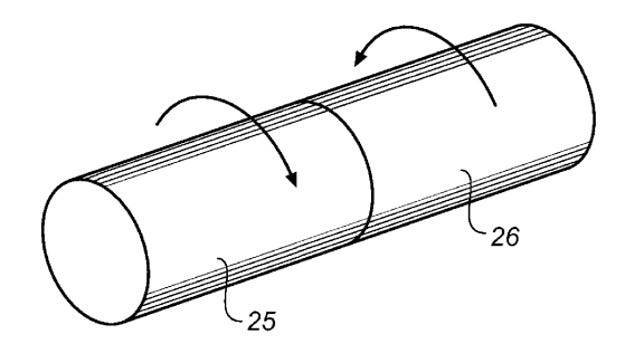
Apple/USPTO
Apple has applied for a patent on a twist-happy wireless hotspot, the US Patent and Trademark Office revealed Thursday.
Apple’s patent application, filed in 2013 but not published till Thursday, describes a new-look cellular hotspot that would capture a wireless carrier’s cell signal, convert it to Wi-Fi and cast it out to wireless devices so they could connect to the Internet. Unlike many other hotspots, the Apple invention would ditch all buttons and turn on with a simple twist of one end of the cylindrical device, which the application describes as “compact.”
The patent seems to follow the design concept Apple has tried to bring to most of its devices and accessories: simplicity. That simplicity comes through in several Apple products, like the minimally buttoned Apple TV remote, the plug-and-play iMac computers and the touch-gesture-friendly Magic Mouse. Wireless hotspots that would potentially compete with Apple’s invention typically come with a handful of buttons designed to help users connect to a network and other devices.
In Apple’s patent application, the company specifically noted that its hotspot invention was designed to be simple in its functionality. When the hotspot is turned off, the two ends of the cylinder are in a neutral position. Twisting one end turns the signal on, allowing devices to connect. In addition to nixing buttons, the cylinder tucks all its critical components, like an antenna and power supply, inside.
“The electronics, antenna and power supply are contained within the device,” Apple writes in its patent application. “The cylindrical portions may be separated to access the internal components. The power supply is included in one of the cylindrical portions and may be interchangeable with power supplies of different capacities.”
One could question whether the hotspot is even necessary. While there are still wireless hotspots that connect a cell company’s network to Wi-Fi-enabled devices, Apple’s mobile devices, including the iPhone, can act as a cellular hotspot. So in effect they can achieve the same goal of sharing a wireless carrier’s network with other products without requiring a user to buy a separate device.
There are, however, some use cases where a separate wireless hotspot might make sense, like when a device such as the iPhone is unavailable.
Whether the hotspot will ever make it to store shelves remains to be seen. Like other companies, Apple often files for patents on technologies that are never released. It’s unknown whether its hotspot will join that group or if it will indeed be available at some point in the future.
Apple declined to comment on the patent application.



